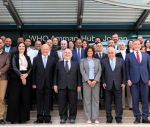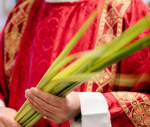You are here
Khirbet Al Batrawy reveals rural rebirth after urban collapse
By Saeb Rawashdeh - Apr 06,2025 - Last updated at Apr 06,2025

Khirbet Al Batrawy, located near Zarqa, was a significant Bronze Age centre (Photo courtesy of Sapienza University of Rome)
AMMAN — The final destruction of the EB II-III city at Khirbet Al Batrawy was followed by a relatively short period of abandonment (BatrawyIVa, Early Bronze IVA, 2,300-2,200 BC), said an Italian archaeologist Daria Montanari.
Montanari added that the ruins of the city were re-occupied by several clusters of dwellings irregularly displaced all over the mound and belonging to a rural village dating to the final part of the Early Bronze IV (BatrawyIVb, Early Bronze IVB, 2,200-2,000 BC).
"The earliest nucleus of houses arose just inside the collapsed EB II-III city-wall in the northern sector of the site, in Area B, along the edge of an embankment made up with the remains of earlier collapsed structures," the archaeologist noted.
"Here, a sequence of two occupational phases of domestic units and installations illustrates the progressive growth of the village," said Daria Montanari, adding that the latest phase included several dwellings with domestic devices for food preparation and storage.
From east to west, it was represented by the corner of a quite substantial house which showed a relatively solid fieldstone masonry, and a rectangular stone-paved installation inside it, while outside the building to the west an open area with a very partially preserved stone-flagged pavement had been badly ravaged by later pillage activities.
"To the west, in the central sector of the excavated area, the more recent phase included a wide square house, with working platforms and a semi-circular central installation devoted to food production and storage [with a platform and a bin], while outside the northern wall of the house a square juxtaposed unit with a bench probably represented an auxiliary storeroom," Montanari explained.
The archaeologist added that further north, a child burial was set underneath the northern boundary wall of the dwelling.
To the west, a rectangular structure, abutting directly over the inner edge of the collapsed city-wall, was characterised by a stone-paved double installation, presumably devoted to the processing of liquids (grape juice/wine), Montanari elaborated.
The archaeologist pointed out that in the central sector, underneath central House, sparse remains of an ephemeral earlier occupationof the village were uncovered, including hearths, cistsand stone platforms.
"Hole-mouth jars fragments found in large quantity spread all over the area belong to the same EB IVB local horizon of pottery as the ones retrieved in the overlying more substantial structures, thus testifying to that the latest sedentary occupation of the site homogenously belongs to the final part of the Early Bronze IV [BatrawyIVb, Early Bronze IVB, 2,200-2,000 BC]," Montanari underlined.
She stressed that a major cluster of houses was excavated on the Acropolis.
To the west, two major rectangular units opened towards a courtyard, each showing a series of installations for food transformation and other devices.
Finds in dwellings
Flint and stone tools, as well as pottery from these dwellings, provide a wide representative inventory of domestic materials of this period. In the eastern sector of the Acropolis, a distinctive feature was a boundary wall (W.23+W.5), which delimitated the eastern edge of the village by terracing the collapsed remains of the underlying town, she said.
The archaeologist added that two domestic units flanked a path, each one consisting of a main rectangular living room, subsidiary chambers and several annexed spaces, with installations for food preparation and storage, including circular silos, working platforms, benches and some curvilinear devices.
"A distinguished feature of this architecture was the irregular arrangement around courtyards and lanes, the curvilinear layout of annexes in respect of the main rooms, and the adoption of single-line unworked stone walls, which supported ceilings made of leafy branches or, in some cases, simple corbelled vaults."
"The overall picture provided by Area A is, thus, that of a relatively small village with rectangular houses flanked by courtyards and subsidiary structures in use for a single constructive phase," Montanari elaborated.
Moreover, a third group of houses was excavated on the easternmost terrace of the khirbet, in Area F, where again rectangular units represented the main dwelling model, with some food processing installations inside (platforms, mortars, etc.) and adjoined curvilinear storage devices.
"Such dwellings, similarly to the ones in Area A, showed only a single stratigraphic phase, and they presumably represent a somewhat short-lived occupation of Terrace V, towards the end of Early Bronze IV," Montanari said.
The archaeologist added that a major house was identified, including a large unit, with a raised platform and a cist in the middle, a round bin in the south-eastern corner, and a separated rectangular room in the opposite south-western corner.
"The above mentioned structures spread over several spots of the site, providing a quite rich set of materials belonging to the last phase of the Early Bronze IV," the archaeologist said.
"These structures also testify to the process of ephemeral re-sedentarisation and reverse to a rural based economy at the end of Early Bronze Age in the Upper Wadi az-Zarqa Valley, when the major site of the district was Jebel er-Reheil," Montanari concluded.















